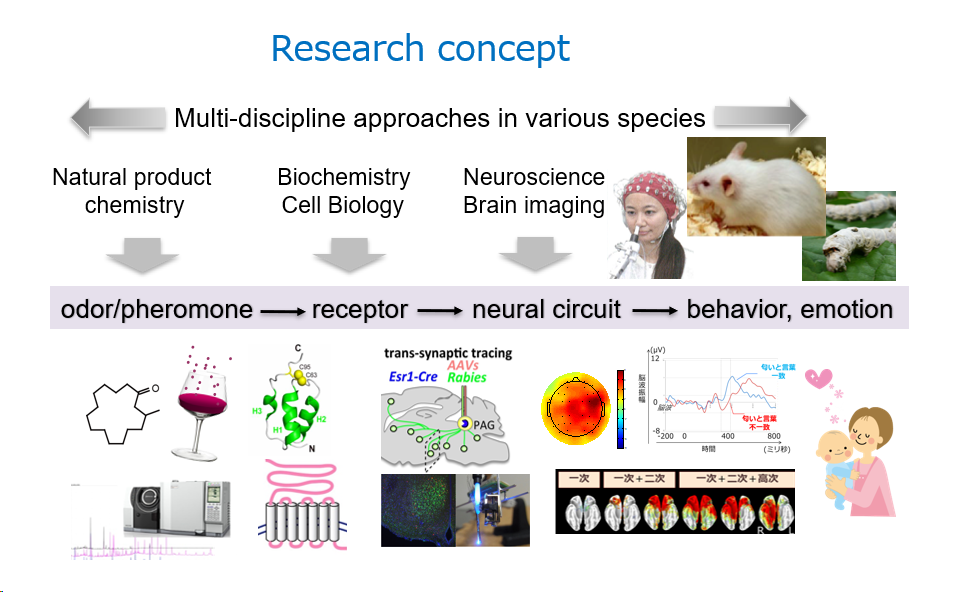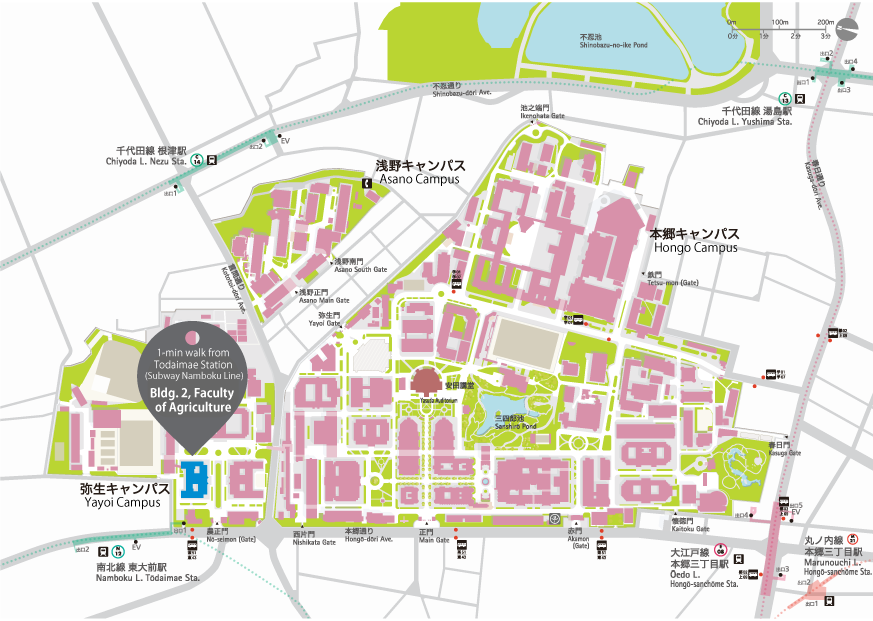RESEARCH
Chemical senses - odors, pheromones
Using interdisciplinary approaches, we are trying to elucidate the mechanisms underlying chemosensory perception from peripheral receptors to the higher brain in various species, including mice, insects, and humans.
In human society, the sense of smell is positioned as an invaluable sense among the five senses, but in fact, in many organisms, behaviors and habits essential for survival, such as food recognition, individual recognition, and induction of reproductive activity, are controlled by chemical information such as odors and pheromones. We seek to elucidate olfactory sensory mechanisms at the molecular, cellular, and individual levels, from peripheral receptors to the higher brain, using interdisciplinary ideas and techniques, including molecular biology, neuroscience, cell physiology, and biochemistry. We also aim to elucidate the mechanism of chemoreception as a means of communication within and between species, and how organisms receive and recognize signals from the outside world and how their behavior and instincts are regulated.
Read More
Specifically, we analyze the structural and functional aspects of olfactory and pheromone receptors belonging to the 7-transmembrane receptor family. Since our group is at the forefront of functional analysis of olfactory receptors worldwide, we focus on receptors for structurally interesting and physiologically active odorant molecules. In the field of pheromones, we start by finding and identifying pheromone molecules in mice and then identify their receptors and analyze their functions. In particular, we target pheromone receptors expressed in the vomeronasal organ, a chemosensory organ that is highly developed in rodent species. Once the target odor and pheromone receptors are identified, we will try to visualize the neural network that transmits information to the brain by creating different genetically engineered mice and using genetic manipulation techniques with different viruses. In insects, we are analyzing the function of olfactory and gustatory receptors that control feeding behavior in the silkworm, Bombyx mori. We are also focusing on the human sense of smell, using non-invasive brain measures such as EEG and fMRI, and trying to decipher the emotional responses to odors, such as pleasantness and unpleasantness, and the semantic memory and value of odors from brain activity.

Current ongoing projects:
- Screening and structural characterization of odors and pheromones that induce various behavioral and physiological changes in mice and humans.
- Structure and function of odorant and pheromone receptors in mice, insects and humans.
- Human olfactory receptor gene polymorphisms and perception
- Pheromone neural circuits in the brain that control behavior, emotion and physiology using viral engineering techniques in mice
- Psychology, physiology and brain measures (EEG, fMRI) to elucidate olfactory functions in humans.
Basic olfactory research is attractive not only because it is an extremely interdisciplinary field of study, considering its relationship with behavior, ecology and evolution as a sensory system that has not changed since primitive times, and its relationship with the endocrine system as an effect of aromas and pheromones on the organism. It is also attractive in terms of pharmacology as the ultimate molecular recognition of hundreds of thousands of odorants. Inter-individual communication by pheromones is an important phenomenon for mate recognition, reproductive isolation, and species conservation, and the study of pheromones is a very important perspective for understanding sexual evolution and human evolution.
We humans also tend to forget that the sense of smell is important in the perception of deliciousness when we eat. Only humans can use all five senses in a balanced way. Our basic olfactory research has many practical aspects that can be applied to food science in the pursuit of taste, as well as to clinical olfactory diagnosis and the development of olfactory sensors for the safety of society. It is important for humans to maintain a balanced sense of the five senses in order to lead a healthy life. We believe that one of the sensory sciences in the post-genomic era is to cherish the landscape of "smell" that is being lost from our society and to construct a rigorously designed olfactory space. We would like to reaffirm the need for human communication, which is gradually being lost in the computer information society, and explore new ways of using the sense of smell that will lead to the well-being of humankind, with the goal of enriching people's nutritional lives.
MEMBER
| Faculty staff: | |
|---|---|
| Kazushige Touhara Profile | Professor |
| Masako Okamoto | Associate Professor |
| Sayoko Ihara | Assistant Professor |
| Koji Sato | Research Associate Professor |
| Ken Murata | Research Assistant Professor |
| Postdoctoral fellows: | |
|---|---|
| Kosuke Saito | |
| Stella Chapman | |
| Guyot Matthieu | |
| Satomi Okabe |
| Graduate Student (Doctoral Program): | |
|---|---|
| Akari Kanbe | |
| Taro Munakata |
| Graduate Student (Master's Program): | |
|---|---|
| Seita Furukawa | |
| Haruka Taniai | |
| Yuma Ikeda | |
| Yui Fujita | |
| Mizuki Hosono | |
| Syuichi Saitou | |
| Yuki Nagai | |
| Moe Nishimoto | |
| Yuki Hatano |
| Undergraduate Student: | |
|---|---|
| Daiki Furuta |
| Technical Assistant: | |
|---|---|
| Saki Okamura | |
| Rieko Kawamura | |
| Aimi Makino | |
| Shinobu Kaneko |
| Research Administrator: | |
|---|---|
| Rieko Tada |
ACCESS
Laboratory Locations
Room 203, Bldg. 2, Faculty of Agriculture, The University of Tokyo, 1-1-1 Yayoi, Bunkyo-ku, Tokyo

Closest Station
- 1 minute walk from Todaimae Station (Subway Namboku Line) 8 min. walk from Nezu Station (Subway Chiyoda Line)
- 12 min. walk from Hongo-sanchome Station (Subway Marunouchi Line) 10 min. walk from Kasuga Station (Subway Mita Line)
- 10 min. walk from Hongo Sanchome Station (Subway Oedo Line)
Contact
1-1-1 Yayoi, Bunkyo-ku, Tokyo 113-8657, Japan
Department of Applied Biosciences, Graduate School of Agricultural and Life Sciences, The University of Tokyo
Professor Kazushige Touhara : Biological Laboratory (Room 203, Building 2, Faculty of Agriculture)
TEL : 03-5841-5109 FAX : 03-5841-8024
E_MAIL ADDRESS : ktouhara[AT]g.ecc.u-tokyo.ac.jp
Associate Professor Masako Okamoto : Biological Laboratory (Room 55, Building 2, Faculty of Agriculture)
TEL : 03-5841-8043 FAX : 03-5841-8024
E_MAIL ADDRESS : a-okmoto[AT]g.ecc.u-tokyo.ac.jp



